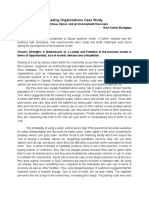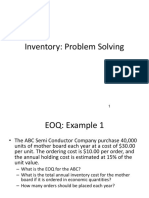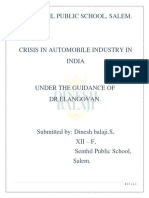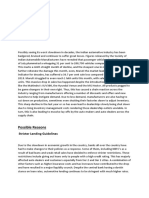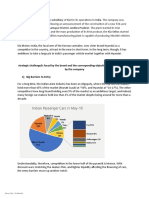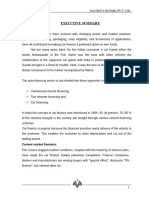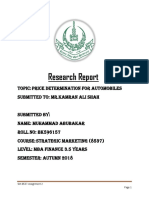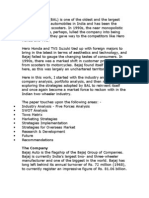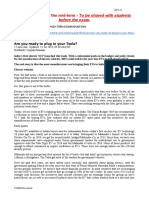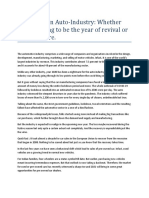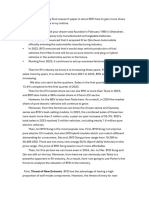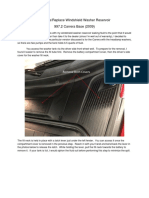Slowdown in Automobile Sector
Slowdown in Automobile Sector
Uploaded by
DEEPAK YCopyright:
Available Formats
Slowdown in Automobile Sector
Slowdown in Automobile Sector
Uploaded by
DEEPAK YOriginal Title
Copyright
Available Formats
Share this document
Did you find this document useful?
Is this content inappropriate?
Copyright:
Available Formats
Slowdown in Automobile Sector
Slowdown in Automobile Sector
Uploaded by
DEEPAK YCopyright:
Available Formats
Deepak Yadav
D-14 |PRN: 20020441077
SLOWDOWN IN THE
AUTOMOBILE SECTOR
Trends till March 2019
TRENDS AFTER MARCH 2019
In July 2019, the sale of vehicles across categories in the country slumped 18.71% to about 18.25 lakh units,
down from about 22.45 lakh units, a year ago in the same month. This has been the steepest fall in nearly 19
years. This data, by the Society of Indian Automobile Manufacturers (SIAM), gives out wholesale figures i.e.
the number of vehicles dispatched to dealers by vehicle manufacturers. The passenger vehicle segment, which
comprises cars, utility vehicles and vans, has been one of the worst performing segments, registering its highest
drop in sales since December 2000: almost 31%, to a little over two lakh units from nearly 2.91 lakh units in
July 2018. This was also the ninth straight drop in monthly passenger vehicle sales. In fact, barring a low single
digit uptick in October 2018, segment sales have been falling for the past year. With the industry failing to
arrest the downturn that started almost a year ago, despite deep discounts and new model launches, it has been
forced to undertake production cuts. This has also led to the trimming of over 2.15 lakh jobs in the sector.
REASONS FOR SLOWDOWN IN AUTOMOBILE SECTOR
1. Harder To Get Loans
*All the graphs and data are taken from SIAM
Deepak Yadav
D-14 |PRN: 20020441077
In the current economic environment, banks have become more strict about giving out loans, favouring only
those individuals with high CIBIL scores. Transunion CIBIL tracks and monitors the loan repayment histories
of financial consumers in India and is a trusted establishment used by banks and financial institutions to assess a
person’s credit worthiness.
Since people with lower CIBIL scores are not able to get loans as
easily, they are not able to purchase high value assets, such as cars.
Banks are also being stringent in lending money to dealers to
capitalize their inventory. Often, the production numbers for car
manufacturers are helped by their dealerships placing orders to stock
up for potential customers. So, if dealers cannot get loans as easily,
then they too will order fewer units.
2. Confusion around BS6 emission standards
Bharat Stage 6, more commonly referred to as BS6, is a
standard of emission norms set by the government of
India. These norms apply to both fuel and the engine.
By April 2020, the BS6 emission norms will come into
effect and all car manufacturers will have to upgrade their
engine offerings accordingly. Not all carmakers have
clarified their position regarding the upcoming shift and
how it will affect their product lineup that is offered to
customers. As a result, certain buyers are delaying their
new car purchase until there are more details available
regarding BS6-compliant model choices.
Availability of BS6 fuel across the country is another
uncertainty of the public.
3. Uncertainty of Diesel in the BS6 era
Whether carmakers upgrade existing engines to meet the upcoming BS6 emission norms or make new ones, it is
a big investment. The extra cost will undoubtedly be borne by the customers as well in the prices of the final
product - the car.
Upgrading petrol engines is relatively cheaper thanks to the more refined nature of the fuel itself. For instance,
Maruti updated majority of its petrol engines to be BS6
compliant while keeping the price bump to just under Rs 30,000.
However, there is a huge cost in making diesel engines
compliant to BS6 standards with an expected jump of at least a
lakh rupees for all diesel-powered variants of different cars.
Diesel cars already command a significant premium over their
naturally-aspirated petrol engine variants.
*All the graphs and data are taken from SIAM
Deepak Yadav
D-14 |PRN: 20020441077
Smaller, affordable cars which use smaller, more fuel efficient
diesel engines amount for a considerable volume of total car sales.
If these get too pricey relative to the petrol variants, fewer people
are likely to opt for it. As a result, not all small diesel engines will
continue to be offered in the BS6-era.
This uncertainty from carmakers has also resulted in hesitation
from those who would likely buy a new diesel-powered car.
4. Waiting for attractive deals closer to BS6
implementation
The above mentioned points have also led to some new car buyers to wait for
the BS6 deadline to draw closer in order to get the best possible deals.
Dealerships and carmakers are expected to be scrambling to get rid of new
car inventory with BS4 engines while they can still get registered. In that
rush, buyers are likely to be offered ridiculous discounts to get those models
off their hands.
A similar situation already happened in 2017 when the sale of BS3 vehicles was banned. Certain manufacturers,
particularly from the two-wheeler industry, were still hoping for an extension on the deadline for the sale of
BS3 models. However, when the decision and date were finalised, manufacturers offered great discounts to get
rid of their BS3 inventory.
5. The UBER-OLA Factor
Taxis have been around for many decades. However, they
were always quite expensive, hard to find and taxi drivers
were infamous for their unreliable services. Today, thanks to
the boon of the smartphone and cheap internet, we have
convenient cab services from apps like Uber and Ola.
In fact, in the last year or so, these two apps have gone
beyond just booking a cab; they even allow you to book auto-rickshaws and motorbikes for shorter distances.
With the added convenience of online fare payments, the use of these apps for smaller commutes seems a more
favourable prospect than buying your own car and the hassles that come with it.
6. Big Cities Are Too Crowded
Speaking of the hassles of owning a car, the first one to mind
is that of being stuck in traffic. A large volume of car sales is
driven by young, upcoming professionals with growing
incomes and fewer liabilities. But even if
you have the money to buy a car, you will likely spend a lot of
your time driving it in congested traffic and/ or looking for a
suitable parking space.
*All the graphs and data are taken from SIAM
Deepak Yadav
D-14 |PRN: 20020441077
The stress of having your car scratched by a careless delivery-rider or auto rickshaw or cabbie in traffic or in a
tight parking spot is no small matter. A regular commute with plenty of traffic takes up a lot of time and energy
as well. Time and energy that could be spent working or resting in the back of an Uber/Ola cab during your
commute.
7. Too many back-to- back changes in the industry
When there is too much going on in terms of changes and uncertainties
regarding regulations and government policy, it is almost common sense
to sit back and not act until things have settled down. The car industry
today is in a similar state.
In the last year or so, there have been numerous changes enforced by new
regulations with more changes on the way. From mandatory safety features for all new cars to increasing the
road tax, rising insurance costs to upcoming emission norms. Each of these types of changes, even if necessary,
tend to lead to an increase in prices which deters new buyers in the mass market.
8. The Electrification Equation
Even the government’s rhetoric surrounding electric mobility and electric vehicles leaves many uncertainties for
both carmaker and buyers about what to invest in and more critically, when to invest.
Affordable EVs with sufficient range are a must for the electric
mobility shift to become reality. However, this goal is harder than it
seems as the current battery technology is not at that stage yet and
neither is their charging infrastructure.
Promises made and goals set are not enough for the breakthrough that
is required to make e-mobility a mass market option in India. The
production and development of electric powertrains, battery tech and
charging infrastructure is still in its early stages and will likely take another 5 to 8 years before mass EV
adoption begins. Recently, the government has reduced GST rates for EVs in India. However, its effectiveness
in the EV-push has not been as confidence inspiring as some may have hoped, largely due to the surrounding
factors mentioned above.
9. Demonetization and BS-III Vehicles Ban
Demonetization impacted the Automobile industry
significantly. The domestic CV sales contracted by a sharp
11.6% in November 2016. Passenger Vehicle (PV) industry
slowed down during Nov-16. The two wheeler and three
wheeler segments also took a significant hit during the month of November. Car sales were at their lowest in the
last 16 years in the month of December, 2016. The overall dip in the sale of automobiles has been recorded at
19 per cent to 12.21 lakh units in December 2016. Not just the sale of automobiles, their overall production also
went down by 22 per cent as carmakers scrambled to cut production in the face of falling demand. The month of
December 2016 saw a dip in the production of two-wheelers by 25 per cent and the production of commercial
*All the graphs and data are taken from SIAM
Deepak Yadav
D-14 |PRN: 20020441077
vehicles by 20 per cent. Overall vehicle sales in December 2016 were down by 18.66 percent compared to a
5.48 percent drop in November 2016.
As per the CRISIL report when the ruling came, the two wheeler inventory risk was at 670,000 units,
amounting to 3,800 Crore. Among the two-
wheeler players, Hero MotoCorp, TVS Motors
and Honda Motorcycles and Scooters, were
found to be with large pile of BS III bikes.
According to one brokerage house tracking the
automobile industry, actual vehicle population
affected by the ban is a mere 8,24,278 out of
238,56,956 produced between April 2016 and
February 2017.
10. Corona Virus
PwC has warned
SIAM of steep fall
in sales in FY21-
18 per cent for two wheelers, 12 per cent for passenger cars and 21 per cent in the
case of commercial vehicles.
It points out that the commercial vehicles segment is already carrying excess
capacity (GST impact and lower axle lading movement of goods due to the weak
economy). With logistics disruption likely to continue in hot zones and customers
in no mood to invest, this sector will show a delayed recovery, said PwC.
PWC also predicted that there will be
a sharp downgrading by buyers –
consumers who buy passenger cars or
two wheelers will go one segment
lower. But one good thing it said is
that online sales will now grow across
the auto sector. Also, rural market
recovery will be slower than urban.
This will have repercussions on sale
of two wheelers.
GROUP OPINION ( isme sabka cover ho jayega bus GST wala conclusion add kardo)
*All the graphs and data are taken from SIAM
Deepak Yadav
D-14 |PRN: 20020441077
COVID-19 will impact all stakeholders in the value chain who will experience both short and medium term
impact. This could range from shortage of raw material, shifting of production to other countries, liquidity
crunch to delays in availability of models, deferred launches and shrinkage in consumer demand.
SHORT TERM SHORT TERM SHORT TERM SHORT TERM
Shortage in component Decline in production, Decline in customers foot Rise in online
parts- China’s production especially BS6 due to falls. platforms & increase
slowly coming up but supply chain/ labour Liquidity crunch due to in traffic ( e.g.
supply chain disruptions disruptions because of blocked working capital in CarDekho, CarWale in
remain. lockdowns. BS4 inventory & loan India)
Reallocation of production Delayed availability of tightening. Even as use of online
parts to indian suppliers BS6, post testing and Drop in automotive demand plaforms increases,
due to bottlenecks in gobal certification. due to price increase for BS6 actual sales could drop
supply chain. Potential decline in transition, slowing economy, due to low consumer
Possible decrease in export planned BS4 sales as it slow loan availability & lower confidence.
orders due to shut down in was expected to pick up consumer confidence. Decrease in Ola/Uber
Europe/USA. in March. demand due to
Possible Liquidity crunch lockdown & work
for suppliers due to from home.
increased inventory( No
production by OEMs)
MEDIUM TERM MEDIUM TERM MEDIUM TERM MEDIUM TERM
Possible increase in Make Potential extended Potential sustained drop in Potential for enduring
in India as global & Indian waiting times for new demand due to drop in shift to online
supply chain mitigate models (incl. BS6 consumer confidence, shifting purchasing channels
supply risks versions) due to from a ‘supply’ problem to a due to this impetus.
Possible decrease in disruptions in ‘demand’ problem. Potential for reduced
exports as global players productions. Possible spike in consumer cab demand due to
may diversify supply chain. Increase in demand for demand due to social shift in employer’s
spares due to pent up distancing ( personal, shared behaviour for work
demand during lockdown. & public transport mobility) from home policies
Possible shortage of Surge in demand for spares etc.
temporary labor because and services due to pent up
of people moving to demand during lockdown.
hometown.
*All the graphs and data are taken from SIAM
You might also like
- Autonation The Changing Auto Dealership LandscapeDocument12 pagesAutonation The Changing Auto Dealership Landscapechandler749No ratings yet
- Kia Motors: Positioning and Growth Strategies in IndiaDocument7 pagesKia Motors: Positioning and Growth Strategies in IndiaAmmar AhmadNo ratings yet
- Zipcar Case AnalysisDocument8 pagesZipcar Case AnalysisJay Prakash Upadhyaya100% (2)
- Leading Organizations Case StudyDocument3 pagesLeading Organizations Case Studyburagapuravi60% (5)
- Harley-Davidson Strategic AnalysisDocument29 pagesHarley-Davidson Strategic Analysisharicane92% (49)
- 365 Sports Cars You Must Drive 9780760369777 9780760369784 9780760340455 2011023803 - CompressDocument322 pages365 Sports Cars You Must Drive 9780760369777 9780760369784 9780760340455 2011023803 - CompressMiguel Angel De Jesus AlvarezNo ratings yet
- Factors Affecting Demand Supply of Automobile IndustryDocument7 pagesFactors Affecting Demand Supply of Automobile IndustryNalin Gupta83% (23)
- Group 3 - Mahindra Electric Mobility Case SolutionDocument7 pagesGroup 3 - Mahindra Electric Mobility Case SolutionVipulGarg0% (1)
- Zipcar CaseDocument3 pagesZipcar CasemeriemNo ratings yet
- Inventory ExamplesDocument5 pagesInventory ExamplesBoboako NapolesNo ratings yet
- Vice City 100% Checklist TemplateDocument25 pagesVice City 100% Checklist TemplateafshanNo ratings yet
- 2012 Kawasaki Vulcan 900 Classic 52548Document177 pages2012 Kawasaki Vulcan 900 Classic 52548Diego MonteiroNo ratings yet
- Senthil Public SchoolDocument17 pagesSenthil Public Schooldinesh balajiNo ratings yet
- Possible Reasons: Stricter Lending GuidelinesDocument3 pagesPossible Reasons: Stricter Lending GuidelinesAryanNo ratings yet
- CarsDocument4 pagesCarsSibasish AccharyaNo ratings yet
- Project Report On Maruti Showroom ManagementDocument92 pagesProject Report On Maruti Showroom Managementneoratm100% (1)
- Penilaian PiyushDocument7 pagesPenilaian PiyushScribdTranslationsNo ratings yet
- Introduction of Electric VehiclesDocument1 pageIntroduction of Electric VehiclesAman SaxenaNo ratings yet
- Marketing AssignmentDocument7 pagesMarketing AssignmentMamuni PandaNo ratings yet
- Project Report On Maruti Showroom Manage - 230914 - 115759Document92 pagesProject Report On Maruti Showroom Manage - 230914 - 115759vishal birajdarNo ratings yet
- Automobile Industry AnalysisDocument22 pagesAutomobile Industry AnalysisAbhishekNo ratings yet
- A Study On The Marketing Mix Strategies of Mercedes BenzDocument29 pagesA Study On The Marketing Mix Strategies of Mercedes BenzMurphy JimmonsNo ratings yet
- Critical Analysis of Motorcycle Sector in IndiaDocument7 pagesCritical Analysis of Motorcycle Sector in IndiaDeep HojaiNo ratings yet
- A Possible Upturn in The Auto Sector - BusinessDocument5 pagesA Possible Upturn in The Auto Sector - Businessmartinchriss900No ratings yet
- Bajaj Auto - Case AnalysisDocument7 pagesBajaj Auto - Case Analysisadnan0% (1)
- Case StudyDocument15 pagesCase StudyAamir SaleemNo ratings yet
- Internship ReportDocument51 pagesInternship Reportshubhangi gargNo ratings yet
- IntroductionDocument33 pagesIntroductionTanzim Rafat AyonNo ratings yet
- Rhb-Report-My Auto-Autoparts Sector-Update 20230117 Rhb-483379665709538263c5cdd47633e 1673939044Document8 pagesRhb-Report-My Auto-Autoparts Sector-Update 20230117 Rhb-483379665709538263c5cdd47633e 1673939044Premier Consult SolutionsNo ratings yet
- Rishabh Gadkar CB AssignmentDocument5 pagesRishabh Gadkar CB AssignmentRishabh GadkarNo ratings yet
- PoV Auto Retail 2018Document8 pagesPoV Auto Retail 2018Rohit JangidNo ratings yet
- Not Characters.: 1) Please Explain in Detail at Least Two Reasons For This Plunge. (Minimum 200 Words) It Is WordsDocument3 pagesNot Characters.: 1) Please Explain in Detail at Least Two Reasons For This Plunge. (Minimum 200 Words) It Is WordsShriya ChandrakarNo ratings yet
- Premium Bike Market in IndiaDocument5 pagesPremium Bike Market in Indiaarun_gauravNo ratings yet
- Zipcar AnalysisDocument7 pagesZipcar AnalysisSudan Pudasaini100% (2)
- Car Company ReportDocument10 pagesCar Company ReportTrident ManagementNo ratings yet
- PROJECT REPORT On Car Loan - Docx 222222.docx DJDocument63 pagesPROJECT REPORT On Car Loan - Docx 222222.docx DJyashNo ratings yet
- Price Determination For AutomobilesDocument11 pagesPrice Determination For AutomobilesAbubakarNo ratings yet
- The Future of Hybrid Electric Vehicles: Marketing 6525 Case StudyDocument13 pagesThe Future of Hybrid Electric Vehicles: Marketing 6525 Case StudyAkshit SobtiNo ratings yet
- Automobile Sector White Paper - 2021Document25 pagesAutomobile Sector White Paper - 2021Xsellence AccountsNo ratings yet
- Report About Market ShareDocument16 pagesReport About Market ShareRenault BDNo ratings yet
- Bajaj Auto LTDDocument17 pagesBajaj Auto LTDAvinav ThapaNo ratings yet
- Consumer Perception Towards Agriculture Tractors 60 HP Class A Comparative Study of Mahindra Mahindra and EscortDocument58 pagesConsumer Perception Towards Agriculture Tractors 60 HP Class A Comparative Study of Mahindra Mahindra and Escortdeepak sharmaNo ratings yet
- Bajaj AutoDocument9 pagesBajaj AutoDeepesh VaishyaNo ratings yet
- BAV DocumentDocument32 pagesBAV DocumentPARIMI NAXITH ABHIRAMNo ratings yet
- A Project Report ON Marketing Strategy of Bajaj Auto: Anurag ManwarDocument41 pagesA Project Report ON Marketing Strategy of Bajaj Auto: Anurag ManwarAnuraag ManwarNo ratings yet
- Market Overview Diesel Emissions Conference India 2012 WBDocument4 pagesMarket Overview Diesel Emissions Conference India 2012 WBBurkert IndiaNo ratings yet
- 20UHCMD111 3rd Sem ProjectDocument47 pages20UHCMD111 3rd Sem ProjectPooja GoyalNo ratings yet
- Macroeconomics Assignment: Dr. Pooja Mishra & Professor Jagdish ShittegarDocument10 pagesMacroeconomics Assignment: Dr. Pooja Mishra & Professor Jagdish Shittegarvishnu sehrawatNo ratings yet
- Sentiments, High Import Duties Companies (NBFC) SectorDocument1 pageSentiments, High Import Duties Companies (NBFC) SectorSurbhi SabharwalNo ratings yet
- Apollo FinalDocument25 pagesApollo FinalMuhammad Aafaq KhanNo ratings yet
- M&M EVDocument5 pagesM&M EVMahima MehraNo ratings yet
- Car ASSIGNMENT 2Document19 pagesCar ASSIGNMENT 2maddiedanielle033No ratings yet
- Automobile Crisis-Gap: What Is " "?Document5 pagesAutomobile Crisis-Gap: What Is " "?Saptashwa MukherjeeNo ratings yet
- Presented To: Mr. P.P.Singh (FACULTY, P.C.T.E.) Presented By: Himanshu Sood Rajat Gupta Sonu Nath Sumit ThaparDocument50 pagesPresented To: Mr. P.P.Singh (FACULTY, P.C.T.E.) Presented By: Himanshu Sood Rajat Gupta Sonu Nath Sumit ThaparD Attitude KidNo ratings yet
- Case Material For The Mid-Term - To Be Shared With StudentsDocument6 pagesCase Material For The Mid-Term - To Be Shared With StudentsNilesh kumarNo ratings yet
- Strategic Issue: Threat of New Entrants-LowDocument7 pagesStrategic Issue: Threat of New Entrants-LowRohan JohnNo ratings yet
- Commercial PlaybookDocument13 pagesCommercial Playbooksomu ghoraiNo ratings yet
- The Slump in Auto IndustryDocument3 pagesThe Slump in Auto IndustryDrishti SwapanNo ratings yet
- BYD 10 MinsDocument4 pagesBYD 10 Minspennyapple0201No ratings yet
- Running Head: Big Drive Auto Business Recommendations 1Document6 pagesRunning Head: Big Drive Auto Business Recommendations 1Arlene W. Gross AnfossiNo ratings yet
- Case Study - The Electric Car Dream - Sandeep Bhasin AIBS - Amity UniversityDocument5 pagesCase Study - The Electric Car Dream - Sandeep Bhasin AIBS - Amity UniversitySandeep BhasinNo ratings yet
- CHAPTERDocument4 pagesCHAPTERsreejithbhasi128No ratings yet
- Car Buying Bahavior Report GCC YallamotorDocument21 pagesCar Buying Bahavior Report GCC YallamotorMohammed GayasuddinNo ratings yet
- DisAT-TQ-ENGLISH 1Document2 pagesDisAT-TQ-ENGLISH 1EvelynMartinezNo ratings yet
- Manual Honda Pgm-Fi Diagnostic Tool45Document1 pageManual Honda Pgm-Fi Diagnostic Tool45Faziri Abdul HaqNo ratings yet
- Historical Rita Wiring GuidesDocument20 pagesHistorical Rita Wiring GuidesM. RexNo ratings yet
- Art - Appleyard - Livable StreetsDocument7 pagesArt - Appleyard - Livable StreetsJuan Sebastian Navia GarciaNo ratings yet
- CompareDocument7 pagesComparesifatsakibulalamNo ratings yet
- Porsche 997.1 Wiper Motor RepairDocument8 pagesPorsche 997.1 Wiper Motor Repairwachu73No ratings yet
- AdventureWorks Products1Document16 pagesAdventureWorks Products1Anny AlNo ratings yet
- Types of Four-Wheel Drive SystemsDocument2 pagesTypes of Four-Wheel Drive SystemsambasszadorNo ratings yet
- Motorcycle Engine Parts and Their FunctionsDocument3 pagesMotorcycle Engine Parts and Their FunctionsGovind Nakhate0% (1)
- Spare Parts Catalogue: Vespa ET4 150 LeaderDocument75 pagesSpare Parts Catalogue: Vespa ET4 150 LeaderEkaGalaSopanaNo ratings yet
- Haynes Tomos A3k A3m A3ms Amp A3ml Mopeds Owners Workshop Manual 1850106789 9781850106784 CompressDocument104 pagesHaynes Tomos A3k A3m A3ms Amp A3ml Mopeds Owners Workshop Manual 1850106789 9781850106784 CompressTomaž VidmarNo ratings yet
- Destini 125 (Oct 2018)Document87 pagesDestini 125 (Oct 2018)gauravsukraliyaNo ratings yet
- 27 Vehicles For Sale in CanadaDocument1 page27 Vehicles For Sale in Canadaw5kms8jtz5No ratings yet
- Chenard-WalckerDocument5 pagesChenard-WalckerSadegh SobhiNo ratings yet
- Data Ajuan KJP Tahap 2Document90 pagesData Ajuan KJP Tahap 2sdn.petukangan.utara05No ratings yet
- Us2 e 76 Word Detective Context Clues Activity Sheet - Ver - 2 UnlockedDocument2 pagesUs2 e 76 Word Detective Context Clues Activity Sheet - Ver - 2 Unlockedstevecsmith12No ratings yet
- Dok WP Bed 21 53000264 Om Sen Awsg v1 11422Document28 pagesDok WP Bed 21 53000264 Om Sen Awsg v1 11422ties.bertens1No ratings yet
- Tokyo by BikeDocument3 pagesTokyo by BikechowjacoNo ratings yet
- User Manual EZEEDocument18 pagesUser Manual EZEESean TanNo ratings yet
- Folding and Self-Propelling Bicycle: Morteza Hanifezade and Arian AshrafiDocument5 pagesFolding and Self-Propelling Bicycle: Morteza Hanifezade and Arian Ashrafiomshivoham1996No ratings yet
- Basiccalculus11 q3 Mod12 RelatedratesproblemsDocument25 pagesBasiccalculus11 q3 Mod12 RelatedratesproblemsMelanie Ibarra Carlos100% (1)
- Preview Activity (I) : Mountain Cycling City / Urban CyclingDocument6 pagesPreview Activity (I) : Mountain Cycling City / Urban CyclingMicchael LehnsNo ratings yet
- Mi Su184Document2 pagesMi Su184jasonyoung1046No ratings yet
- Chapter 1Document2 pagesChapter 1Nor-man KusainNo ratings yet
- Chains and BeltsDocument14 pagesChains and BeltsJoselito GarciaNo ratings yet



